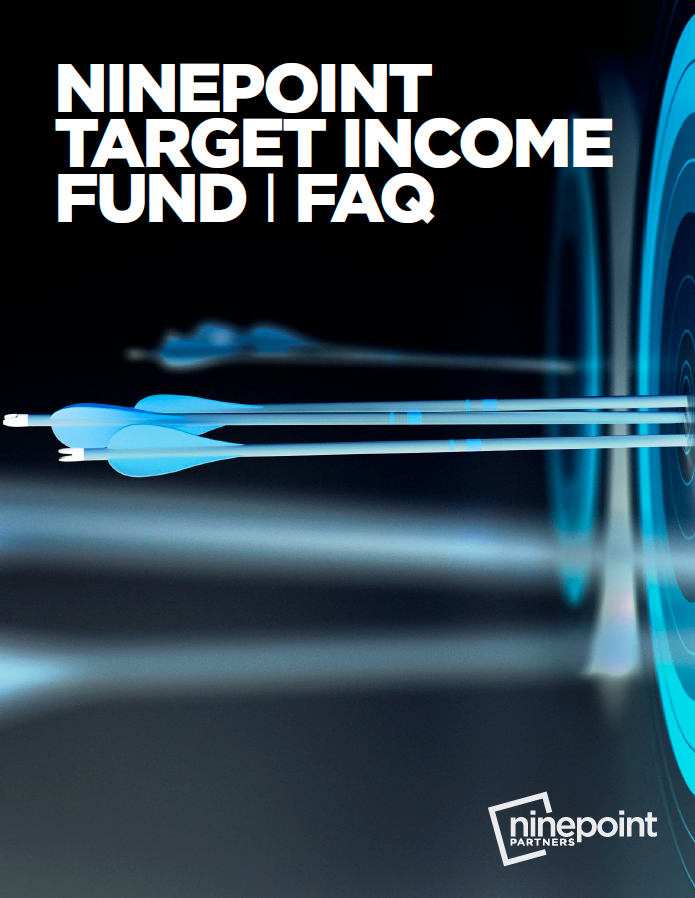Overview
A defensive equity income strategy that employs cash secured put selling to help solve income portfolio challenges.
-
Defensive Equity Income Strategy
Generates an annual 5%†† target income distribution with potential for moderate downside protection in market declines.
-
Income Diversification
Provides a differentiated income stream via put option premiums to complement traditional income portfolios.
-
Active Risk Management
Ability to manage risk and index exposures to achieve investment goals.
Fund Objective
The investment objective of the Ninepoint Target Income Fund is to seek to provide unitholders with stable, monthly distributions and lower volatility than a direct investment in the broad equity markets by investing primarily in a diversified portfolio of equity index based investments that generates income and using derivatives strategies to moderate the market volatility of those investments.
Investment Team
-
 Colin WatsonVice President, Portfolio Manager
Colin WatsonVice President, Portfolio Manager Colin WatsonVice President, Portfolio ManagerColin Watson's background spans across equities, asset allocation & derivative-based strategies. Prior to Ninepoint Partners, Colin worked as a Portfolio Manager at IMCO on a team responsible for overseeing IMCO’s $26B public equity allocation and deploying derivatives-based strategies for IMCO’s public asset allocation strategy. Prior to IMCO, Colin worked at Ninepoint Partners on equity selection & options-based overlays. Colin holds a Bachelor of Commerce Degree from McMaster Unive...View Full Bio
Colin WatsonVice President, Portfolio ManagerColin Watson's background spans across equities, asset allocation & derivative-based strategies. Prior to Ninepoint Partners, Colin worked as a Portfolio Manager at IMCO on a team responsible for overseeing IMCO’s $26B public equity allocation and deploying derivatives-based strategies for IMCO’s public asset allocation strategy. Prior to IMCO, Colin worked at Ninepoint Partners on equity selection & options-based overlays. Colin holds a Bachelor of Commerce Degree from McMaster Unive...View Full Bio -
 Etienne Bordeleau-Labrecque, MBA, CFAVice President, Portfolio Manager
Etienne Bordeleau-Labrecque, MBA, CFAVice President, Portfolio Manager Etienne Bordeleau-Labrecque, MBA, CFAVice President, Portfolio ManagerEtienne Bordeleau-Labrecque is Vice President, Portfolio Manager at Ninepoint Partners. With over 10 years of expertise across equities, interest rates and credit, he now focuses primarily on the firm’s Fixed Income franchise. Prior to Ninepoint’s formation, Etienne was with Sprott Asset Management (SAM) from 2012, where he worked as an Analyst and Associate Portfolio Manager, covering North American equities in the financial, energy, utility and health care sectors. From 2008 to 2011, Étienn...LinkedIn View Full Bio
Etienne Bordeleau-Labrecque, MBA, CFAVice President, Portfolio ManagerEtienne Bordeleau-Labrecque is Vice President, Portfolio Manager at Ninepoint Partners. With over 10 years of expertise across equities, interest rates and credit, he now focuses primarily on the firm’s Fixed Income franchise. Prior to Ninepoint’s formation, Etienne was with Sprott Asset Management (SAM) from 2012, where he worked as an Analyst and Associate Portfolio Manager, covering North American equities in the financial, energy, utility and health care sectors. From 2008 to 2011, Étienn...LinkedIn View Full Bio





